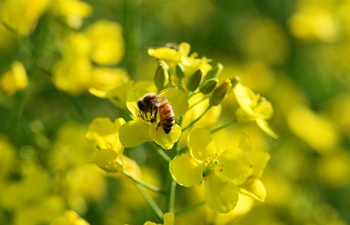NAIROBI, Jan. 23 (Xinhua) -- Farmers across the east African region are expected to have access to high-yielding, drought and disease resistant finger millet, a scientist revealed on Wednesday.
Damaris Odeny, principal investigator of the Crop Wild Relatives (CWR) project at the International Crops Research Institute for the Semi-Arid Tropics (ICRISAT), said that the project that has involved research on finger millet's wild relatives have also developed tolerance to blast disease and striga, a parasitic weed.
"We plan to release farmer-preferred and superior varieties next year to help improve farmer's productivity," Odeny told reporters in Nairobi.
She said researchers have developed the new varieties from identified finger millet qualities preferred by farmers and consumers.
Odeny noted that the wild relatives have been used because some of them have grown alongside cultivated finger millet on farmers' fields and are not affected by either striga or blast disease.
The scientists observed that finger millet is a highly valued crop with nutritional qualities and recognized as a smart food yet production has remained below its expected potential.
Odeny said that the study was done following farmers' claim that the two key constraints to increased production are the blast and striga.
"We intend to avail to farmers varieties that do not only withstand drought but also resist diseases and striga to help them increase production," said Odeny.
Henry Ojulong, a cereals breeder at ICRISAT, said that even though finger millet is a preferred crop in the region, it is heavily affected by blast disease.
Ojulong revealed that the disease affects the crop in all stages of plant growth including leaves, neck and fingers.
"In Kenya, blast can cause an estimated average yield loss of about 30 percent while striga, a sap-sucking weed, can lead to a complete loss of crops and once it's in a farmer's field, it is nearly impossible to eradicate," said Ojulong.
The researchers who also included a team from Kenya Agricultural and Livestock Research Organization and Maseno University are currently introducing unique characteristics from wild finger millet into cultivated varieties.
The study has been hailed since finger millet is high nutritional and its health qualities include high levels of calcium, iron and amino acids.
"It is an ideal food for diabetics since it has high amounts of slowly digestible starch and resistant starch that contribute to a slow release of sugar in to the bloodstream," Ojulong added.
It is the most important small millet in the tropics and is cultivated in about 25 countries in Africa and Asia, predominantly as a staple food grain.
The crop is native to the Ethiopian highlands and was introduced into India some 4,000 years ago. Uganda, Ethiopia, India, Nepal are among the major producers of the crop.
The ICRISAT gene bank holds nearly 6,000 finger millet germplasm accessions from 24 countries, conserved for use in research and development.













